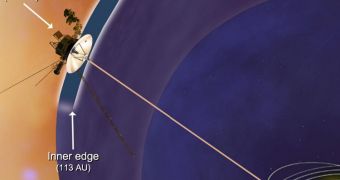According to new calculations by NASA experts, the Voyager 1 space probe is farther away from the edge of the solar system than initially calculated. The spacecraft's main mission, more than three decades after launch, is to reach interstellar space.
In order for it to do that, it first needs to exit the solar system. Since there is no clear boundary set up, it is very difficult to determine when this will happen. The edge is loosely defined as the location where the influence of solar winds is defeated by that of interstellar space.
The transition from one to the other is very, very smooth, explain mission controllers at the NASA Jet Propulsion Laboratory (JPL), in Pasadena, California. The Lab has been managing both Voyager 1 and 2 for more than 35 years, Space reports.
Yesterday, the Voyager 1 mission turned 35, and JPL scientists compiled a new estimate of when the spacecraft would exit the solar system. Surprisingly, they learned that it has a rather long road ahead, definitely longer than what the team believed until now.
They calculated the heliopause – the theoretical boundary between the solar system and interstellar space – as a waypoint, and used data from Voyager 1 to determine that it has not yet reached this location. Previously, they thought that the probe was either on its way out or well into the heliopause.
This boundary is the outermost layer of an area where solar influences begin to be counterbalanced by those of interstellar space. This region is called the heliosheath, and both Voyagers have been flying through it for several years.
“The implication is that the flow of solar wind plasma in the heliosheath is more complex that we had expected,” Johns Hopkins University space physicist Robert Decker explains. He is also the lead author of a new study detailing the findings, published in the September 6 issue of the top journal Nature.
At this point, researchers are unsure as to exactly how large the heliosheath is, or when the heliopause will be reached. According to Decker, experts are still debating this, and apparently, a clear answer is not yet in sight.
“Based on the changes we have seen in the Voyager 1 data during the past year, I would expect that Voyager 1 will cross the heliopause within one year,” the expert concludes.

 14 DAY TRIAL //
14 DAY TRIAL //